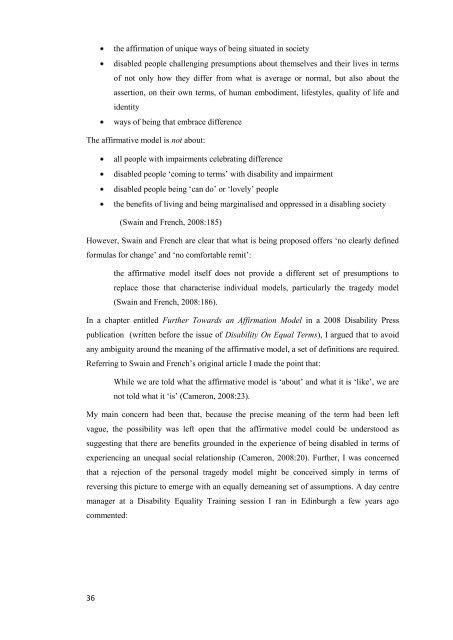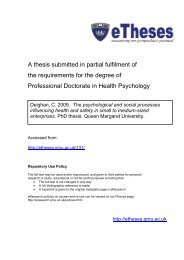- Page 1 and 2: A thesis submitted in partial fulfi
- Page 3 and 4: Abstract I offer a critical explora
- Page 5 and 6: Contents Introduction p.1 Chapter 1
- Page 7 and 8: When I speak of tensions I mean som
- Page 9 and 10: Sutherland, Richard Rieser and Mich
- Page 11 and 12: Chapter 1: Disability, Self and Ide
- Page 13 and 14: 8 Impairment: any loss or abnormali
- Page 15 and 16: unceasing flow of representations,
- Page 17 and 18: a daughter, a Scot, a West Coaster,
- Page 19 and 20: matters of social significance beco
- Page 21 and 22: 16 Which individuality a human bein
- Page 23 and 24: In Elias‟ view it is only when th
- Page 25 and 26: 20 [I‟m] a normal person. The onl
- Page 27 and 28: acknowledgement of the processes by
- Page 29 and 30: This involves a demand for recognit
- Page 31 and 32: Habitus A useful insight can be dra
- Page 33 and 34: as to have no impact on the rest of
- Page 35 and 36: general public acceptance of the po
- Page 37 and 38: 32 the vast and deep injustices tha
- Page 39: modernity has involved many attempt
- Page 43 and 44: described rather than having to rev
- Page 45 and 46: Personal Experience On April 6, 197
- Page 47 and 48: 1100 boys from all over South Bucki
- Page 49 and 50: mother did her best to discourage t
- Page 51 and 52: 46 mind, but to the society in whic
- Page 53 and 54: ut is experienced in the terms of s
- Page 55 and 56: Chapter 3: Methodology Why am I res
- Page 57 and 58: 52 developing a theory, usually bas
- Page 59 and 60: Hamer expresses a view here that
- Page 61 and 62: nor is it satisfied with the interp
- Page 63 and 64: Why not grounded theory? 58 The int
- Page 65 and 66: 60 We set aside our prejudgements,
- Page 67 and 68: events for disabled peoples‟ orga
- Page 69 and 70: populations (Atkinson and Flint, 20
- Page 71 and 72: terms of other groups of individual
- Page 73 and 74: Jennie, a woman in her mid-thirties
- Page 75 and 76: (Kusenbach, 2003) in which I accomp
- Page 77 and 78: to me. I had expected interviewing
- Page 79 and 80: 74 that we go about the daily neces
- Page 81 and 82: Participants returned the scripts r
- Page 83 and 84: l = line 1: = interview number 24ff
- Page 85 and 86: 80 I‟m being pushed into a subjec
- Page 87 and 88: The emergence of a sense of differe
- Page 89 and 90: 84 I saw the other disabled kids an
- Page 91 and 92:
work and independent living, the ch
- Page 93 and 94:
88 all the time we were extolled to
- Page 95 and 96:
The theme is repeated that being in
- Page 97 and 98:
Hazel struggled to recall any other
- Page 99 and 100:
94 to one of my aunties‟ for a pa
- Page 101 and 102:
The sense of standing in isolation,
- Page 103 and 104:
Rose‟s husband suggests the possi
- Page 105 and 106:
100 they feel nervous to ask “Wel
- Page 107 and 108:
102 extent, you know, I spent… un
- Page 109 and 110:
104 pain…” (laughs)… “Do yo
- Page 111 and 112:
ound the hat rack‟. Her relief at
- Page 113 and 114:
108 definite contexts of meanings c
- Page 115 and 116:
What I find compelling in Thomas‟
- Page 117 and 118:
within different discourses. While
- Page 119 and 120:
My revised definition of disability
- Page 121 and 122:
Chapter 5: Disability as Role Intro
- Page 123 and 124:
Person-first thinking is supported
- Page 125 and 126:
120 minicom… but these are just
- Page 127 and 128:
A different reason A related, thoug
- Page 129 and 130:
124 never mind…” does not impro
- Page 131 and 132:
126 abnormal, if you like, and more
- Page 133 and 134:
less powerful social group. Indeed,
- Page 135 and 136:
130 was a case of I just cut off al
- Page 137 and 138:
132 I can remember having an argume
- Page 139 and 140:
134 there‟s never any representat
- Page 141 and 142:
people regard other disabled people
- Page 143 and 144:
138 earth haven‟t you had a shag
- Page 145 and 146:
140 Sadie used to do amazing things
- Page 147 and 148:
Lola recalls that she was regarded
- Page 149 and 150:
144 weekly… I get on really fine
- Page 151 and 152:
146 situations together… erm… c
- Page 153 and 154:
In gaining an understanding of the
- Page 155 and 156:
however, their descriptions of havi
- Page 157 and 158:
152 more often than not they are me
- Page 159 and 160:
to negative subject positioning, wi
- Page 161 and 162:
significance of impairment, this ha
- Page 163 and 164:
As someone with adult experience of
- Page 165 and 166:
argues, by the repetitive, structur
- Page 167 and 168:
162 psychologically speaking, this
- Page 169 and 170:
usually involve blind characters be
- Page 171 and 172:
166 other indecent part of it … a
- Page 173 and 174:
It begins to appear that the proble
- Page 175 and 176:
170 on Direct Payments or Individua
- Page 177 and 178:
172 increasingly becomes more impor
- Page 179 and 180:
Anne‟s statement here reflects th
- Page 181 and 182:
176 Society really does view all di
- Page 183 and 184:
Unsurprisingly, I reject Ouellette
- Page 185 and 186:
Initially Ali confesses to watching
- Page 187 and 188:
as „awful‟ - we can see again t
- Page 189 and 190:
184 you‟ve been brought up and ho
- Page 191 and 192:
debate the choices that are display
- Page 193 and 194:
188 media stereotypes - of race, ag
- Page 195 and 196:
190 I didn‟t start noticing them
- Page 197 and 198:
192 think about it… if it was…
- Page 199 and 200:
William Stothers, who describes him
- Page 201 and 202:
Opportunities for disabled people t
- Page 203 and 204:
198 part of society watching the te
- Page 205 and 206:
Chapter 7: Disability in Everyday L
- Page 207 and 208:
always somebody worse off‟ natura
- Page 209 and 210:
lasted several hours and others onl
- Page 211 and 212:
caught by something else she wanted
- Page 213 and 214:
“At the moment you‟re looking a
- Page 215 and 216:
The camera has already focussed upo
- Page 217 and 218:
Given that Cumberbatch and Negrine
- Page 219 and 220:
What‟s going on? Emma Bowler rece
- Page 221 and 222:
216 characters in that that were re
- Page 223 and 224:
While he described himself as takin
- Page 225 and 226:
experienced by Donald as he waited
- Page 227 and 228:
222 get back to Dundee... will Angu
- Page 229 and 230:
my feet were broken I spent three m
- Page 231 and 232:
are looking maybe they‟re not but
- Page 233 and 234:
Bus from Brunswick Square to North
- Page 235 and 236:
Toby Miller and Alec McHoul discuss
- Page 237 and 238:
Erin was waiting in the chairs insi
- Page 239 and 240:
Or if I do I want to be employed do
- Page 241 and 242:
crammed bookcases and decorated wit
- Page 243 and 244:
238 society, er … like, life... I
- Page 245 and 246:
240 (l.3:503ff.) While the transcri
- Page 247 and 248:
sense of solidarity and purpose tha
- Page 249 and 250:
244 sharing it you gain so much str
- Page 251 and 252:
space (l.3:140ff.) It was only duri
- Page 253 and 254:
248 Well... the point is the way I
- Page 255 and 256:
250 Sartre describes how the act of
- Page 257 and 258:
ought their children along. Neither
- Page 259 and 260:
Conclusion I conclude by re-visitin
- Page 261 and 262:
256 dealings with the world is when
- Page 263 and 264:
of the affirmative model will hold
- Page 265 and 266:
References Access 4 U 2 (2009) Term
- Page 267 and 268:
Burchardt, T. (2005) The education
- Page 269 and 270:
Elias, N. (2000) The Civilising Pro
- Page 271 and 272:
Klages, M. (1999) Woeful Affliction
- Page 273 and 274:
Paralympics.com (2004) Paralympian
- Page 275 and 276:
Stevens, S. (2008) „Movement Does
- Page 277 and 278:
Wilson, T. (1995) Watching Televisi
- Page 279 and 280:
274 Appendix B: Email Extracts I ha
- Page 281 and 282:
I first of all must say that I thin
- Page 283 and 284:
The discussion, comments and observ
- Page 285 and 286:
280 Appendix D: Themes arising from
- Page 287 and 288:
10. Political identity as disabled




